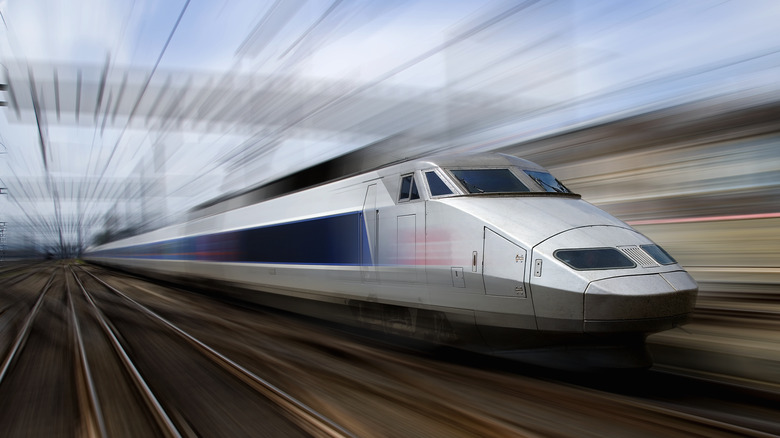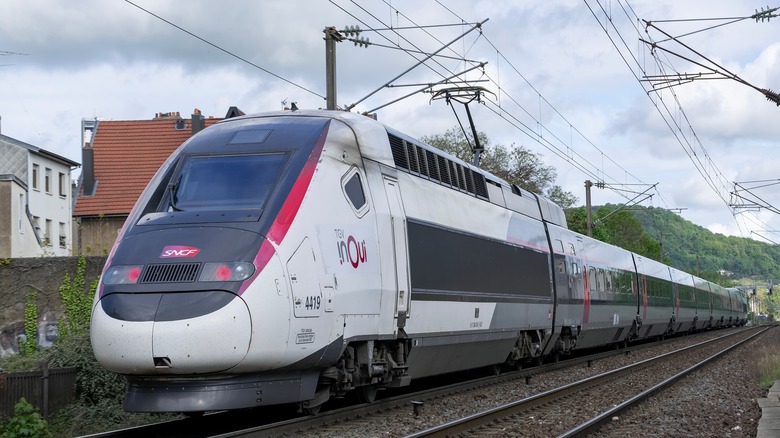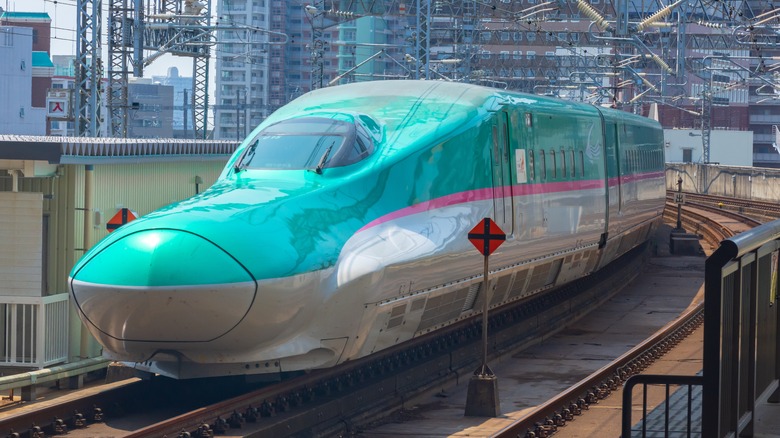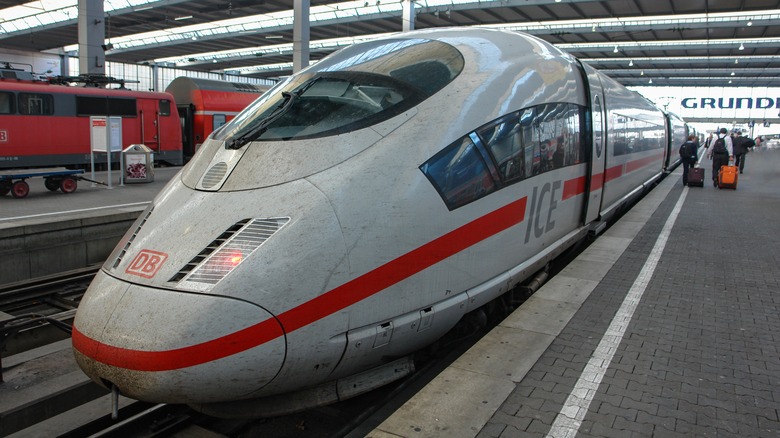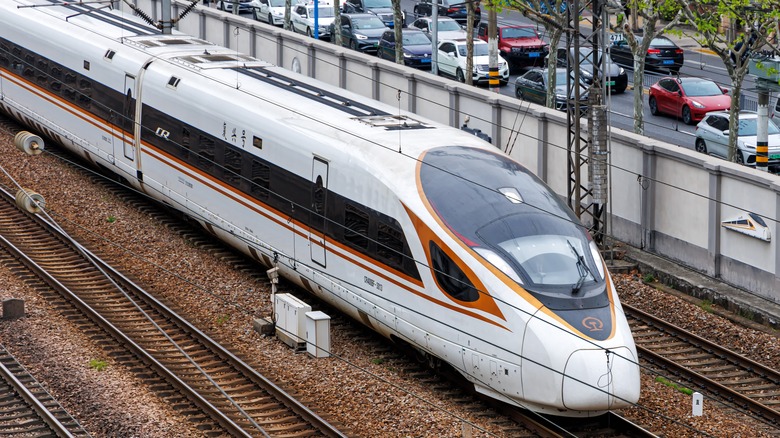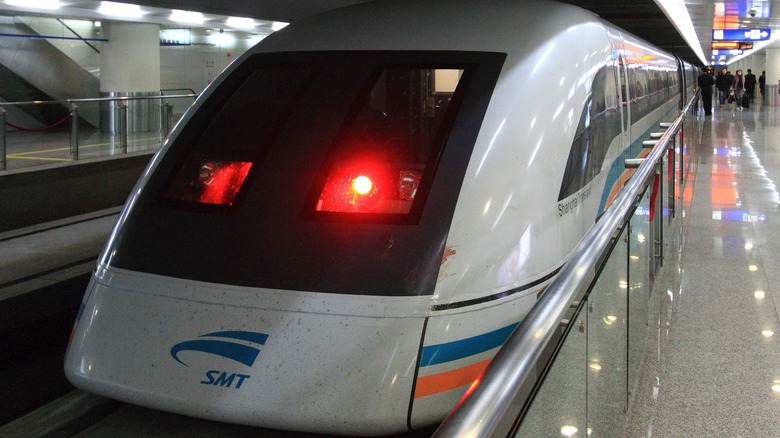The 5 Fastest High-Speed Trains In Operation Today
For most Americans, trains are less a part of their daily lives than they are a part of the nation's history. When most people think of trains, they likely recall seeing steam engine locomotives in movies or museums. The reason for this has to do with a lack of investment in the rail lines and train technology of the United States. While they're used primarily for transporting vehicles, commodities, and freight, passenger trains aren't used by the public nearly as much as airplanes or personal cars.
Elsewhere in the world, that's not the case. If you look into the rail lines in Europe and Asia, you'll not only find trains running constantly all over the place, but you'll also find the fastest trains in the world. American trains lumber along, blocking traffic for extended periods of time, while European and Asian trains race by at hundreds of miles per hour. Bullet trains, maglev trains, and other innovations keep them moving.
The world's fastest trains are all located across the pond on both sides of the United States, and their speeds are impressive. While they don't move along at the same speed as a jet airplane, most are operated with incredible efficiency, keeping time and making their stops without delay. This makes high-speed passenger rail systems around the world some of the best means of moving from place to place, and these five trains are the fastest of them all.
5. TGV - France
The TGV is France's primary high-speed train that operates throughout the nation and into several countries within Europe. These include Italy, Germany, Spain, Belgium, and Luxembourg, though an additional line operated by TGV Lyria moves people from France to Switzerland and back. The French train has been operating since 1981, and it went on to set records for the fastest average speed, including a test train in April 2007 that achieved 343.6 mph.
That speed was attained through reduced weight and in atypical test conditions. When operating normally, the TGV, which stands for très grande vitesse (very high speed), can reach a maximum speed of 200 mph. The first TGV prototype was built with a gas-turbine engine, but subsequent production models embraced electricity provided by overhead lines, which is now the standard throughout many European and Asian nations.
A TGV train features a power car (locomotive) at both ends. The trailing power car collects power from the overhead wiring and feeds it to the leading power car via a cable that extends the length of the train. This process is reversible should the train need to change direction. Each power car has four inverter-driven AC synchronous traction motors, which push the train to exceptional speeds. TGV trains operate on particular tracks that spread across France, covering some 1,700 miles with another 1,600 planned for future development.
4. JR East E5 - Japan
Japan's latest high-speed train is JR East's E5 and H5 Shinkansen Hayabusa. The H5 is a derivative of the E5 meant to operate in colder weather climates, and is limited in speed based on the tracks upon which it runs. The E5, on the other hand, has no such limitation, and when it was introduced in 2011, it was the fastest train in the country. The train has a distinctive look thanks to its incredibly long 49-foot nose and green coloration.
The E5 series bullet train can reach speeds of 200 mph, though it was initially planned to reach 223 mph. The reason for the reduction in speed wasn't due to a technological constraint; rather, JR East chose to reduce the train's speed due to the impact it would have on the environment and the overall value for the money invested. In addition to getting people from A to B swiftly, the E5 comes equipped with a luxurious first class option, so people can ride in style.
The E5 is powered through overhead electric cables, delivering the necessary 25000v 50hz AC power. Each carriage car contains three to four 300-kilowatt traction motors that help push the train to its maximum speed. It takes only two minutes to go from zero to 186 mph, but does it so smoothly that passengers aren't subjected to the physical strains of such a rapid acceleration.
3. Deutsche Bahn ICE 3 - Germany
The ICE 3 is the third generation of high-speed electric trains operated by Deutsche Bahn in Germany. The name ICE refers to Intercity-Express, which is an apt name given that ICE 3 trains move passengers between cities at incredible speeds. The ICE 3 has been operating since 2000, and it is certified to travel up to 210 mph. That said, it has achieved higher speeds, clocking in at 229 mph during a trial run.
Those speeds aren't meant for commercial operation, as the ICE 3 is generally limited to around 200 mph. The ICE 3 accomplishes these speeds without a power car and instead distributes 16 traction motors underneath the entire length of the train. This makes each ICE 3 car part of an Electric Multiple Unit (EMU), essentially making them individually self-propelled. The ICE 3 consists of only eight cars, making it a sort of "half train."
Deutsche Bahn has utilized several different models or classes of ICE 3 trains. These include an international version for Spain, Austria, Switzerland, the Netherlands, Belgium, and France. Throughout Germany, the ICE 3 operates at a maximum speed of 200 mph. The government enforces a speed limit of 200 mph, but when the ICE 3 travels between Berlin, Frankfurt, Hamburg, Cologne, Düsseldorf, and Frankfurt, it's allowed to top out at a higher speed of 205 mph, as it doesn't make stops between cities.
2. CR400 Fuxing - China
When it comes to developing high-speed rail systems, China is no slouch. China began investing in its own high-speed rail system, which is entirely built and maintained within China, relatively recently. The nation's second-fastest train is the Fuxing Hao, also known as the CR series EMU, which began servicing passengers in July 2018. It is operated by China Railway High-speed (CRH) and has been nicknamed the Red Dragon and Golden Phoenix, depending on the model.
There are several variations to the CR400 Fuxing, though some of the fastest operated by CRH, the CR400AF and CR400BF models, can reach speeds of 220 mph. CR400s come in a variety of configurations, including eight, 16, and 17 cars. The trains were designed to reach 250 mph, and in testing, this upper limit was blown out of the water when it set a record of 261 mph. Power is derived from overhead cables, which supply the necessary 25 kV 50 Hz AC, which is the worldwide standard for such systems.
The CR400 Fuxing Hao train lines run throughout China, taking people from Beijing to Shanghai, Beijing to Zian, and Beijing to Tianjin and back again. As the system is expanded, it will take passengers between 16 main provinces in China. The latest model, the CR450, which is undergoing testing and will enter service in 2025, will maintain a cruising speed of nearly 280 mph, upping the average speed of the line by 60 mph.
1. Shanghai Maglev - 286 mph - China
The world's fastest train currently operating resides in China and is known as The Shanghai Maglev Train (SMT). Unlike the other trains mentioned previously, the SMT doesn't make contact with its rails. Instead, it uses magnetic levitation technology to eliminate ground friction, enabling the train to move at breakneck speed. The train's Electromagnetic Suspension (EMS) elevates the cars and propels it forward, ensuring a gap is maintained throughout operation.
Initially, the train traveled at a cruising speed of 268 mph, though after May 2021, its speed was limited to only 186 mph. Unlike the other passenger trains that zip around the world at high speeds, the SMT has a very limited route. It only operates out of two stations: Longyang Road and Pudong International Airport. It covers around 26.7 miles, which takes an average of one hour in a personal car.
The SMT handles that distance in seven minutes and 20 seconds, making it ideal for transporting people to and from the airport. The limited operation makes the SMT more of a commuter train than anything else. Despite its limited operation, the SMT remains the fastest maglev train currently in operation, and it's also the fastest train in the world. It takes around two minutes to reach 220 mph, and when it was being tested, the train reached a max speed of 311 mph, but this isn't a typical operating speed.
